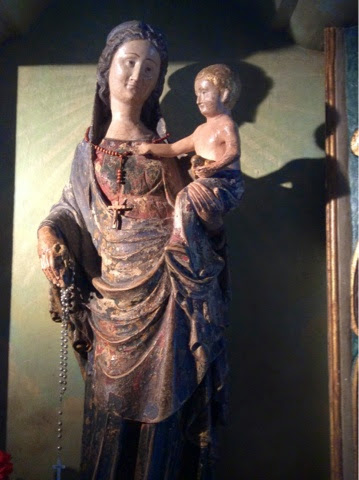The Day dawned foggy and cold after the Cory's Shearwater's mewing call punctuated the night air. Mist drifted across the narrow road as we departed for Velhas to exchange the van for a smaller auto with which to navigate the narrow roads. In the distance a cloud covered sky laced with blue held promise for a sunlit day. We switchbacked up the asphalt road out of Faja do Bodes past stone dwellings. Up, up, up, the nearly vertical mountainside past terraces of stone fenced gardens of kale, beans, squash and fava beans until we were high above the sea on this volcanic mountain.
Saturday, July 12, 2014
Monday, July 7, 2014
Parque Nacional do Penada-Geres
On the fourth day at Casa do Fragão, fog pressed up against the bedroom windows and everything was hidden. We all slept in, recovering from our strenuous hike in Parque Nacional da Peneda-Gerés along walled stone pathways broken by decrepit gates of wood with stone hinges and metal locks. After lunch in the village of Cutelo beside the community cistern, we ascended the rocky stone path through meadow wildflowers, prickly gorse, heather, granite boulders and scattered stone to the top of a range. We ambled across a col which divides two river basins; the Lima River to the north and Rio Homen to the south.The path eventually led us through another ancient Portuguese village with granite paths and dwellings. Two hens took shelter on the cobblestone path beneath a cow with wide brown eyes chewing her cud. Several small dogs barked after us. Stored away in niches attached to the stone dwellings were old rusted carts whose metal wheels had worn grooves in the granite pathways we walked. Villagers till these fields, carrying on the tradition of country living, tending gardens surrounded by high trellises of grapes for vinho verde, lettuce, kale, onion and corn.

Portugal Lady
On our last day in the Minho region, we visited the igreja of Nossa Senhora da Abadia, the oldest sanctuary in Portugal. In a small store beside the church, you can purchase Milagros, wax forms of parts of the body. Inside the cathedral, stairs on either the side of the altar lead to an ancient carved wooden statue of the Virgin. She is located high above the altar, where often in a Catholic Church, one sees the form of the crucified Christ. Standing there before Nossa Senhora da Abadia, one can pray, make an offering, and place the Milagros. Leaving the cathedral, we ascended a path beside a waterfall through woods, and climbed to the top of the knoll where the miracle occurred. While at this sanctuary, busses loaded with visitors arrived. The village of Sta. Maria do Bouro near the sanctuary provided lunch and a walk on narrow cobbled streets. We returned home as the clouds thickened, the air cooled and rain began to fall. The remainder of the afternoon and evening a heavy rain persisted, and we enjoyed shelter from the weather. During the night, I opened the bedroom door to invite in cool air. A cloud blew in, scattering miniature droplets over bare skin. In the morning light rivulets ran down the glass wall, and water sounds were everywhere. Forms were indistinct and the sky so low it touched the cornfields and pressed against the roofs of houses. We packed our bags, said "tchau" to Casa do Fragão, and dropped down out of the clouds heading for the sea!
Subscribe to:
Comments (Atom)

